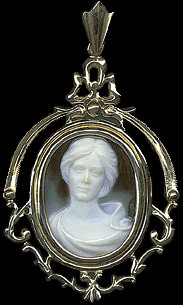The Opal Variety Cacholong
Even in the wide and varied world of gemstones, cacholong is pretty obscure. The stone has certainly generated its share of confusion. Also known as kascholong, the stone is actually a variety of opal, but this hasn't stopped it from being listed as an agate on more than one occasion. It has also been described as either chalcedony or hydrophane opal. The fact that it is sometimes known as "mother of pearl opal" only adds to the complexity.
3 Minute Read
Even in the wide and varied world of gemstones, cacholong is pretty obscure. While it's been known to the gem community for years, your average consumer is more likely to respond to the mention of cacholong with a polite "gesundheit!" The stone has certainly generated its share of confusion.
Also known as kascholong, the stone is actually a variety of opal, but this hasn't stopped it from being listed as an agate on more than one occasion. It has also been described as either chalcedony or hydrophane opal. The fact that it is sometimes known as "mother of pearl opal" only adds to the complexity.
| Photo Courtesy: gliptica.ru |
Cacholong is generally milky white in color, and this neutrality means that the stone is very versatile. It's also extremely porous (hence the confusion with hydrophane opal), and this absorbent nature makes it highly suitable for perfume stones. It has a Mohs hardness of 6, making it easily carved or inlaid.
The stone is found in a number of places Austria and the countries formerly known as Mongolia and Czechoslovakia , to name a few. However, much of the cacholong bought and sold in the world today is sourced from Russia and countries that border that massive nation. The stone is thought to be named after the Cach River , today known as the Kashkadarja a River in the Bukhara province of Uzbekistan , which has long been associated with deposits of cacholong.
Cacholong seems to have initially come to prominence through a number of Russian works of art in the mid to late 1800s, and Emperor Nicholas 11 commissioned a series of Cossack figurines that featured the stone.
A walk through the world famous Hermitage museum in St. Petersburg gives visitors an idea of how the stone was used in 19th century Russian art, especially by the nation's famed mosaicists. One might see, for example, a cacholong daffodil set on a nephrite stem, or a mahogany cabinet with a mosaic of a tropical forest that features cacholong alongside jasper, lapis, and other stones.
One of the Russian artisans whose work is housed in the Hermitage is Oleg Galatin, who has used cacholong in his "glyptic" carving work with cameos and intaglios. Galatin carries on the work of his Russian ancestors, continuing to bring this obscure stone to life.
Until recently, artisans like Galatin were the only ones who used cacholong in jewelry, and their work was highly traditional. Cacholong also tended to play a supporting role in jewelry or objects of art rather than being the main attraction.
All that began to change in late 2002 and early 2003 as some of Europe 's most prominent jewelry companies began to feature cacholong in their jewelry. Leading the way was fashion icon Chanel, which launched its new haute joadlerie collection in early 2003. Cacholong enjoys a high profile in the new designs, being used along with onyx to create carved camellias, Chanel's trademark. This collection neatly demonstrates the versatility of the stone, as cacholong is used both in a more traditional secondary manner for example, on diamond earrings yet takes on a central role as the main stone in a gold ring or necklace.
Picking up on this cue, other jewelry makers have begun using cacholong in everything from beads and rings carved from the stone to jewelry set with carved cacholong. The stone is especially popular in jewelry with a black and white color scheme, where specially cut pieces of cacholong replace the more fragile white enamel.
Whether the stone's sudden popularity will have any longevity is another question. Cacholong is difficult to get, and prices can vary depending on the supplier. While Chanel is about as good a springboard into the jewelry market as any stone could expect, fashion is fleeting even for better known gemstones. If high end jewelers abandon the stone, it's most likely to fade back into obscurity.
If, on the other hand, the current spark of interest brings more cacholong onto the market especially given the popularity of Art Deco style jewelry with carved stones it could be just the boost this Russian classic needs to find a new market niche.
You assume all responsibility and risk for the use of the safety resources available on or through this web page. The International Gem Society LLC does not assume any liability for the materials, information and opinions provided on, or available through, this web page. No advice or information provided by this website shall create any warranty. Reliance on such advice, information or the content of this web page is solely at your own risk, including without limitation any safety guidelines, resources or precautions, or any other information related to safety that may be available on or through this web page. The International Gem Society LLC disclaims any liability for injury, death or damages resulting from the use thereof.
The All-In-One Jewelry Making Solution At Your Fingertips
When you join the Ganoksin community, you get the tools you need to take your work to the next level.
Trusted Jewelry Making Information & Techniques
Sign up to receive the latest articles, techniques, and inspirations with our free newsletter.



